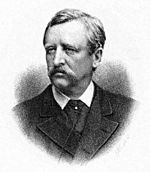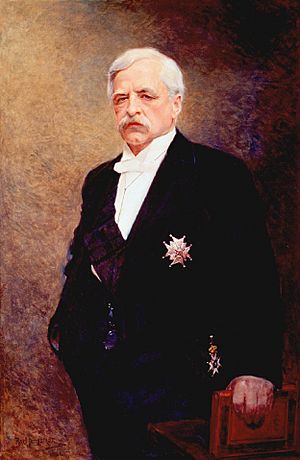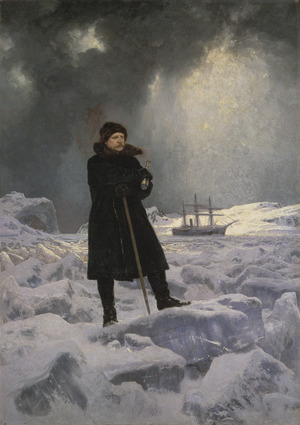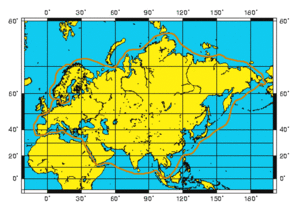Adolf Erik Nordenskiöld facts for kids
Quick facts for kids
Adolf Erik Nordenskiöld
|
|
|---|---|

Adolf Erik Nordenskiöld
|
|
| Born | 18 November 1832 |
| Died | 12 August 1901 (aged 68) |
| Nationality | Finland, Sweden |
| Alma mater | Imperial Alexander University of Finland |
| Known for | Vega Expedition through the Northeast Passage |
| Awards | Founder's Medal of RGS (1869) Constantine Medal (1878) Vega Medal (1881) Murchison Medal (1900) |
| Scientific career | |
| Fields | Geology, mineralogy, cartography |
| Institutions | Naturhistoriska Riksmuseet |
Nils Adolf Erik Nordenskiöld (born November 18, 1832, in Helsinki, Finland, died August 12, 1901, in Dalbyö, Sweden) was a famous Arctic explorer. He was also a scientist who studied rocks and minerals. He came from an important family of scientists in Finland and Sweden.
Nordenskiöld was born in Finland when it was part of the Russian Empire. Later, because of his political ideas, he had to move to Sweden. There, he became a member of the Swedish Parliament and a respected scholar.
He is best known for leading the Vega Expedition in 1878–1879. This journey was the first time anyone had sailed all the way through the Northeast Passage. This route goes along the northern coast of Europe and Asia. His successful trip is seen as a huge achievement in Swedish science history.
Contents
Who Was Adolf Erik Nordenskiöld?
Adolf Erik Nordenskiöld was a remarkable explorer and scientist. He made history by sailing through the icy waters of the Arctic. His work helped us understand more about the Earth and its geography.
About the Nordenskiöld Family
The Nordenskiölds were an old and noble family from Finland and Sweden. Many members of this family were scientists. Adolf Erik's father, Nils Gustaf Nordenskiöld, was a well-known Finnish mineralogist. He also traveled a lot and was part of the Russian Academy of Sciences.
Adolf Erik had sons who also became explorers. His son Gustaf Nordenskiöld explored Mesa Verde National Park. Another son, Erland Nordenskiöld, studied different cultures in South America. Adolf Erik's nephew, Nils Otto Gustaf Nordenskjöld, was also a polar explorer. The Swedish side of the family spelled their name "Nordenskjöld," while the Finnish side used "Nordenskiöld."
Early Life and School
Adolf Erik Nordenskiöld was born in 1832 in Helsinki, the capital of Finland. He spent his early years on his family's estate. He went to school in Porvoo, a small town on Finland's south coast.
In 1849, he started studying at the Imperial Alexander University in Helsinki. He focused on mathematics, geology, chemistry, and mineralogy. He earned his master's degree in 1853. Two years later, he wrote his doctoral paper about the crystal forms of graphite and chondrodite.
After graduating in 1853, Nordenskiöld traveled with his father. They visited the Ural Mountains and studied iron and copper mines. When he returned, he got small jobs at the university and a mining office.
Political Challenges and Moving to Sweden
Nordenskiöld had teachers who believed in liberal ideas. These ideas were against the Russian Empire, which ruled Finland at the time. He spoke openly about wanting Finland to be free.
In 1855, a speech he gave caught the attention of the Russian authorities. This led to him being fired from the university. He then went to Berlin to continue his studies. In 1856, he received money from the university to research geology in Siberia.
However, in 1857, the authorities became suspicious of him again. He was forced to leave Finland and could no longer work at the university there. He moved to Sweden as a political refugee. In 1863, he married Anna Maria Mannerheim. She was the aunt of a famous Finnish leader, Carl Gustaf Emil Mannerheim.
Life in Sweden and Arctic Journeys
Nordenskiöld settled in Stockholm, Sweden. Soon, a geologist named Otto Martin Torell asked him to join an expedition to Spitsbergen. On this trip, Nordenskiöld found ancient plant remains. After the expedition, he became a curator at the Swedish Museum of Natural History. He also became a professor of Mineralogy. In 1869, he received a special award, the Founder's Gold Medal, from the Royal Geographical Society.
Nordenskiöld went on several more Arctic trips between 1867 and 1875. These journeys made him want to find the Northeast Passage. This was a sea route across the top of Europe and Asia that many explorers had tried to find.
He finally achieved this goal on the voyage of the SS Vega. The ship left Karlskrona, Sweden, on June 22, 1878. They sailed past Cape Chelyuskin in August. In September, the ship got stuck in ice near the Bering Strait. They had to wait there through the winter. The next summer, they completed the journey successfully.
When he returned to Sweden, he was given a hero's welcome. In April 1880, he was made a baron. He also wrote a detailed record of his expedition in five books. He wrote a shorter, more popular summary in two books.
In 1883, he visited the east coast of Greenland again. He managed to sail his ship through a huge ice barrier. This was something explorers had tried and failed to do for over 300 years. The captain of the Vega expedition, Louis Palander, was also honored.
In 1893, Nordenskiöld was chosen to be a member of the Swedish Academy. In 1900, he received another award, the Murchison Medal. He was even nominated for the first Nobel Prize in Physics. However, he died in 1901 before the prizes were given out.
A Collector of Old Maps
As an explorer, Nordenskiöld was very interested in the history of Arctic exploration. He especially liked looking at old maps. This led him to collect and study many early maps.
He is famous for two large books he wrote about old maps. These books included many copies of the original maps. They were called the Facsimile-Atlas to the Early History of Cartography (1889) and Periplus (1897).
He gave his huge collection of old maps to the University of Helsinki. In 1997, this collection was added to UNESCO's Memory of the World Register. This means it is considered a very important part of human history.
Amazing Arctic Expeditions
Nordenskiöld went on many expeditions to the Arctic. Here are some of his most important journeys:
- 1858: He joined Otto Martin Torell's first trip to Svalbard. They studied biology and geology along the coast.
- 1861: He went on Torell's second Svalbard trip. They explored the northern coast of Nordaustlandet. They also started measuring a meridian arc, which is a line around the Earth.
- 1864: He led an expedition to finish the meridian arc survey in Svalbard. They also rescued 27 men whose ships were stuck in ice.
- 1868: On the ship Sofia, he sailed farther north in the Eastern Hemisphere than any ship before. He reached 82° 42' N latitude.
- 1870: He visited Greenland to see if using sled dogs would be good for polar trips. He decided it would be too hard to get enough healthy dogs. He traveled about 30 kilometers onto the inland ice. On Disko Island, he found large pieces of native iron. He thought they were meteorites, but now scientists believe the iron came from volcanic eruptions.
- 1872: He tried to reach the North Pole using reindeer. Three ships, Polhem, Onkel Adam, and Gladan, met near Spitsbergen. They all got stuck in the ice. Nordenskiöld had to feed 67 men through the winter. Most of the reindeer escaped, so they couldn't go to the pole. Supplies ran low, and many men got scurvy. Luckily, another explorer found them and shared his food. The ice finally broke, and they returned home.
- 1875: He sailed to the Yenisei River in Siberia. He sent his ship back and traveled up the river by boat, then returned home by land.
- 1876: He repeated the trip to the Yenisei River. This proved that the route was possible even without perfect ice conditions.
- 1878: This was his most famous journey, the first complete trip through the Northeast Passage on the Vega. He sailed around the northern coast of Asia and returned through the Bering Strait.
- 1882–1883: On his second trip to Greenland, he took the ship Sofia to Disko Bay. With three Saami companions, he explored the inland ice sheet. He hoped to find an ice-free area with forests in the middle of Greenland. He had to turn back due to problems, but the Saami traveled 230 kilometers east. On the east coast of Greenland, his expedition was the first in 300 years to get through the thick ice barrier.
Honors and Legacy
Many places are named after Nordenskiöld to honor his discoveries:
- The Nordenskjold Archipelago, a group of islands in the Kara Sea near Siberia.
- The Laptev Sea was once called "Nordenskiöld Sea."
- Nordenskiöld Fjord in Peary Land, Greenland.
- Several glaciers in Greenland and Svalbard, like Nordenskiold Glacier, East Greenland and Nordenskiöldbreen.
- Nordenskiöld crater on Mars.
- In 2007, Finland made a special €10 coin to celebrate his 175th birthday and his discovery of the Northeast Passage.
- A street in Helsinki, Finland, is named Nordenskjöldinkatu (Nordenskiöld street).
See also
 In Spanish: Adolf Erik Nordenskiöld para niños
In Spanish: Adolf Erik Nordenskiöld para niños




